Tagetes lucida
Fresh tarragon lovers in blistering hot regions often have to forgo growing their favorite herb.
French tarragon simply doesn’t thrive in places where it gets really hot and dry. But there’s an herb with a similar flavor called Mexican tarragon (Tagetes lucida) that does extremely well in arid spots.
Then there are those places where French tarragon suffers from rot or other diseases. Mexican tarragon is a great alternative there, too.
That said, this isn’t just an alternative to that classic kitchen herb. It’s a spectacular plant in its own right.

We link to vendors to help you find relevant products. If you buy from one of our links, we may earn a commission.
Beyond the flavorful leaves and available medicinal uses, it’s drought-tolerant, not fussy about soil, and doubles as an ideal ornamental specimen – it’s actually closely related to marigolds.
In fact, it has so much to offer that in its native Mexico, it’s considered by many to be the plant that can do it all.
If you’ve never heard of this wonder plant, or you want to know more, here’s what we’ll go over:
What You’ll Learn
With all it has going for it, who wouldn’t want this plant to become a part of their garden? Let’s get started!
What Is Mexican Tarragon?
Mexican tarragon is a perennial herb native to Mexico and Central America, though its natural habitat is rapidly shrinking due to climate change and deforestation.
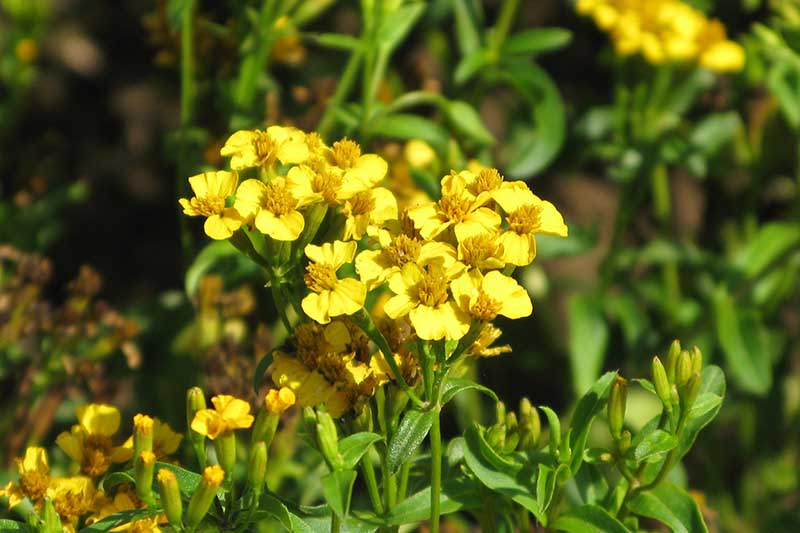
While it belongs to the Asteraceae family along with the more common French tarragon (Artemisia dracunculus), it belongs to a different genus (Tagetes).
It also goes by the names Texas, Spanish, or winter tarragon, as well as sweet mace, yerbis anis, sweet-scented marigold, cloud plant, and Mexican mint marigold.
While French tarragon’s history is largely the story of a classic kitchen herb, Mexican tarragon has a more intriguing past.
In Mexico, native people used it as an incense, medication, a way to subdue captives, and a hallucinogenic in religious ceremonies.
It was used medicinally to treat victims of a lightning strike, and as a poultice to assist people in crossing water safely.
Today, it’s mostly used medicinally and in the kitchen, though there are still people out there experimenting with its more psychoactive attributes.
Speaking of medicinal uses, T. lucida has some real promise in that department. One study found that it has the ability to act as a vasorelaxant, while another confirmed that it has analgesic properties without causing damage to the gastric system like NSAIDs can.
Another study indicates that it has antifungal and antibacterial properties.
So what does this wonder herb look like? The plants grow up to four feet tall and three feet wide. The leaves are glossy green with a lance shape that resembles that of French or Russian tarragon, only slightly wider.
The flowers are yellow, fragrant, and make a showy display in the late summer and early fall.
Grown as a perennial in USDA Hardiness Zones 8 to 11, many people opt to grow it as an annual outside of those regions.
As a perennial, it reaches its full size in about three years. In Zone 8, it may die back to the ground and emerge again in the spring. It’s also a prolific self-seeder if allowed to flower and go to seed.
If you’ve ever let marigolds go to seed and spread in your garden, you know what I’m talking about.
The leaves taste much like French tarragon, though they have less spice and more sweetness, with a hint of licorice.
There have been reports that the leaves can be irritating to the skin, so be sure to wear long sleeves and gloves if this is the case for you.
Cultivation and History
Pericón, as it is known in Mexico, has been used in traditional Mexican medicine to treat everything from depression and anxiety to pain and fevers, as well as cancerous tumors.
It has also been used as an insect repellent, a dye, and as incense. Then, of course, there is its delicious flavor and the pretty flowers, which add a burst of color to the garden.
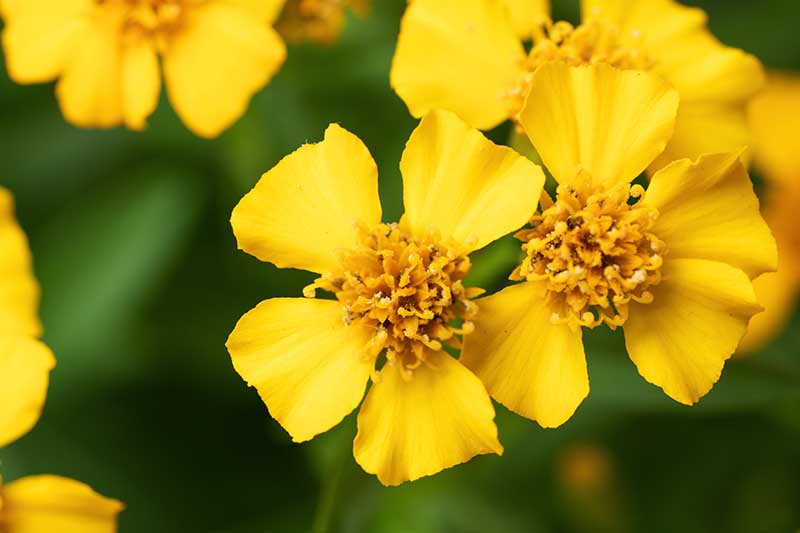
People have been using this plant for thousands of years everywhere from what is now the southwestern part of the United States to modern-day Argentina.
For instance, the Mayans used it to treat malaria and colds.
Aztec people used the powder of the dried leaves to blow in the face of prisoners as an anesthetic, to dull the senses of captives before they were “executed by being burned alive in a great furnace,” according to Robert Trostle Neher in “The Ethnobotany of Tagetes.“
Dr. Neher, a professor in the biology department at the University of La Verne in California, tried sedating himself with the plant in the same way, but found it irritated his mucus membranes too much to have an impact on this state of mind.
He did note that a tea made out of the leaves has a “strong stimulating effect,” however.
The Huichols people of Mexico call Mexican tarragon yauhtli, and they have traditionally smoked it both recreationally and medicinally to take advantage of its hallucinogenic effects.
The Cora people use bundles of the dried leaves and flowers as decoration in their churches. Today, bundles of the herb are also used in Christian religious ceremonies in Mexico and it’s considered an important sacred plant.
In some areas, the Fiesta del Pericón is held every September 28th and 29th to honor San Miguel, and bundles of the herbs are hung in doorways and in churches.
While it’s no longer used to subdue prisoners headed to their death, it’s still used in Mexico and Central America to treat scorpion bites and fevers, and as an aphrodisiac and a traditional remedy for upset stomachs. It also repels nematodes and can kill mosquito larvae.
While it has an important history as a medicinal and religious herb, the plant wasn’t just valued for those purposes. Anywhere that it has been used as medicine, it has also been used to improve the flavor of food.
For instance, the Aztecs used the leaves to make the cocoa-based foamy froth-topped drink chocolatl, and the Mayans used it to flavor everything from meat to veggies. In Mexico and Central America today, it’s frequently added to rice and bean dishes.
The entire plant can also be used to make a gorgeous golden-colored dye. The Zapotec people of Oaxaca value the plant as a traditional natural dye and some artists, such as Porfirio Gutierrez, continue to share the art of making textiles using the plant dye in order to pass the ancient traditions along.
Propagation
Sweet mace isn’t a challenginh plant to reproduce. It grows readily from seeds and cuttings, and via layering or division.
Before you plant, prep your soil if necessary. Since Mexican tarragon isn’t demanding when it comes to soil, it isn’t likely that you will need to do much. If you have extremely sandy or clay soil, you’ll want to work in some well-aged manure or compost to improve the earth.
From Seed
Once all danger of frost has passed in your region, put seeds directly into the ground. Press them into the soil so that they’re just under the surface. Water the soil well and keep it moist as the seeds germinate, which takes about two weeks.
Once the seedlings have emerged and the first set of true leaves have formed, reduce watering so that the top inch of soil dries out in between watering.
Remember that this herb doesn’t like the cold. Anything below 30°F is likely to kill it, so if you want to get a head start on the growing season, you can start seeds indoors about six weeks before the last expected frost date in your area.
Sow seeds in cell plug trays filled with a seed starting medium. You might want to put a few seeds in each cell to ensure that you have a healthy seedling in each one. Just pull any extras that pop up once they are an inch tall or so, leaving one healthy seedling per cell.
Keep the soil moist and reduce watering once the true leaves have formed. Keep the trays in a spot with full sunlight or put them under artificial grow lights for at least six hours per day.
Transplant when the herbs are about six inches tall. Before putting them into your garden, you’ll need to harden them off for about a week.
To do that, take the seedlings outside and put them in a sheltered spot for an hour. Then take them back inside for the rest of the day. On the second day, put them outside for two hours. On the third day, do this for three hours, and so on. After a week, your plant should be ready to stay outside full time.
From Cuttings
This plant grows readily from cuttings. In the spring, take a six-inch stem cutting and remove the leaves from the bottom half. Fill a four-inch container with potting mix, or you can plant the cuttings directly in prepared soil in the garden.
Dip the cut end in rooting hormone powder and insert it into the soil so that a third of the cutting is submerged below the soil surface. Water well so that the soil feels like a well-wrung-out sponge. Keep the soil about that moist or slightly drier for a few weeks, until the plant forms roots.
You’ll know this has happened if you give the plant a little tug and it resists. At that point, you can transplant outside after hardening off as described above. After you’ve planted outside, reduce watering.
From Root Divisions
Not only can you create new plants through root division, but it’s a good idea to divide your herbs every few years to maintain them. Dividing helps give the roots more room and encourages compact growth.
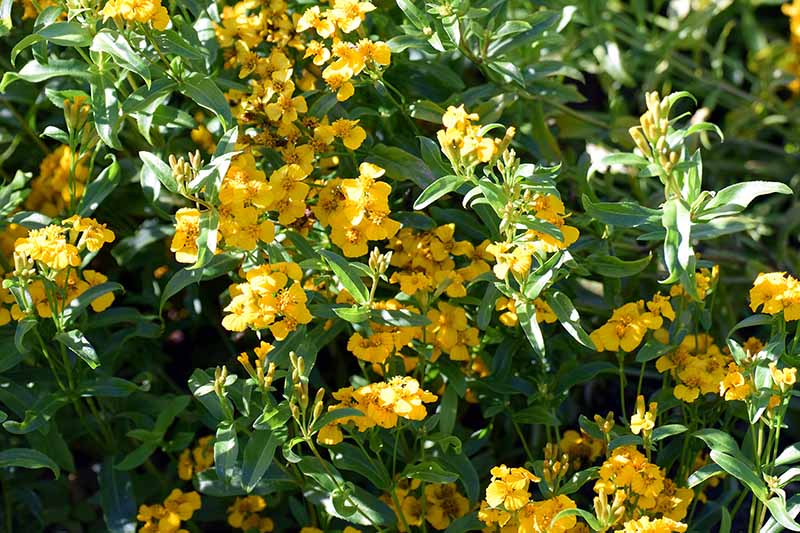
In the spring or fall, dig up as much of the plant as you can by digging a few inches wider than the perimeter of the foliage and about a foot down.
Gently work the herb apart so that you have two equal-sized plants. If the roots are being stubborn, you can cut through them with scissors or a gardening knife.
Replant one half back in the original hole and place the other half in a new spot.
From Layering
Some plants just seem ready to reproduce wherever they touch the ground, and this is one of them. If a branch comes in contact with the soil, it will send out roots.
You can make this work for you by taking a branch that is at least nine inches long and stripping the leaves from the middle. Lay the branch on the soil and lightly cover it with a half-inch of soil.
In a few weeks, give the branch a tug and see if it resists. If it does, cut the stem away from the parent plant and gently dig up the branch and its new roots.
Plant your new herb as you would a transplant.
From Seedlings or Transplanting
Whether you buy transplants, start your own seedlings or cuttings, or divide plants, at some point you’ll want to transplant these into your garden.
To do this, dig a hole that is twice as wide and as deep as the container the plant is growing in. If you’ve dug up your own layered or divided plant, make the hole twice as wide as the existing root structure.
Gently remove the plant from its container and place it in the hole so that it sits at the same height in the soil as it was in the container or the ground.
Fill in around the hole with soil, and water well to settle the soil and roots.
How to Grow
This is one plant that isn’t fussy about the soil you plant it in. It will grow in heavy clay and sandy soil equally well. That said, it prefers well-drained, fertile soil with a pH between 6.5 and 7.0.
It is demanding about sunlight, however. It won’t grow in shade.
Space plants about 18 inches apart. You can put them closer if you are growing them as annuals, since they won’t reach their full size.
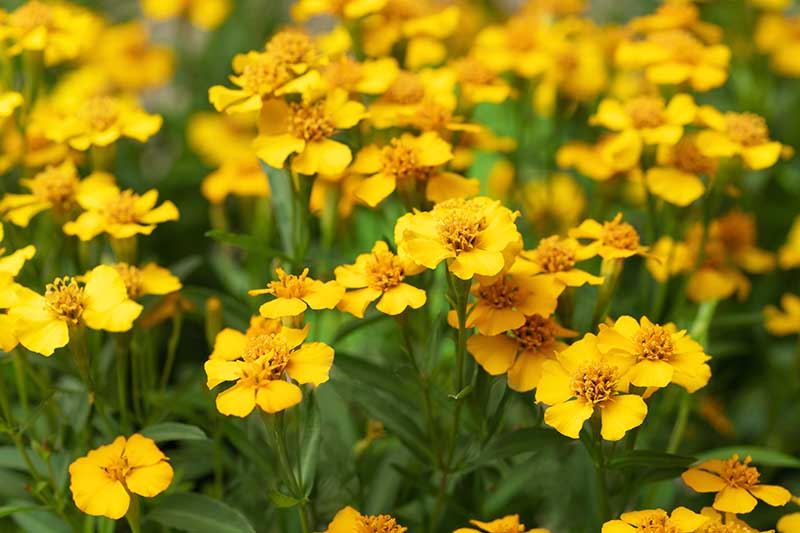
These plants thrive in a mesic to dry habitat. That means they’ll tolerate humidity and wet soil (so long as there is good drainage) as well as drought conditions. Ideally, give the plant more water once the top inch or two of the soil has dried out.
Mexican tarragon grows well in containers, so long as the drainage is good and the pot has a capacity of at least three gallons if you want to grow it as a perennial.
If you want to grow yours in smaller pots as annuals, go for it! Just be sure to repot in a larger container every year thereafter if you’re able to keep them going for longer than a year.
Growing Tips
- Plant in full sun.
- Allow the top inch or two of soil to dry out between watering.
- Feed every two months with an all-purpose fertilizer.
Maintenance
Deadhead regularly if you want to encourage repeat flowering and to discourage plants from going to seed. Divide every few years to improve the health of the plant following the process described above.

Though this plant doesn’t require pruning, you can prune as desired to encourage bushier growth and to create a pleasing shape.
Sweet mace isn’t a hungry plant, but it benefits from regular feedings to encourage lush foliage growth. Feed with an all-purpose fertilizer every other month during the growing season.
Down To Earth’s All-Purpose mix is my go-to.
Down to Earth All Purpose Fertilizer
If you decide you want to add some to your gardening arsenal (and you should!), Arbico Organics has you covered.
Side dress your herbs with two ounces of fertilizer every other month.
Cultivars to Select
The vast majority of seeds and live plants that you will find are sold under the names Mexican mint marigold, winter or Mexican tarragon.
You can find T. lucida seeds available at Botanical Interests.
There is one named cultivar that you may see, and that is T. lucida ‘Anisata.’
‘Anisata’ stays low to the ground, reaching only 12 inches tall when fully mature. It has a spreading habit, and will extend outward up to 18 inches. Otherwise, it looks the same as standard plants.
Managing Pests and Disease
Mexican tarragon doesn’t have a ton of pests and diseases that bother it. In fact, it can actually be used to control many of the common pests that attack vegetable crops.
Take the dreaded root-knot nematode (Meloidogyne spp.), for example. This well-known pest can be incredibly damaging to crops. But T. lucida and other plants in the Tagetes genus may be planted to help control nematodes.
The plant also repels aphids and some types of weevils, and deer and rabbits won’t touch it.
I grew it in the parking strip in front of my house because the area didn’t have any irrigation, and the deer just couldn’t resist taking a swipe at anything and everything I planted there… except yerbis anis.
Having said that, it would be a rare plant that doesn’t have any garden foes, and there’s one type of pest – those slimy little gastropods we all know and hate – that can’t resist sinking their microscopic teeth into Mexican tarragon.
Slugs and snails will make a quick meal out of small plants and can eat quite a bit of foliage off of larger specimens. If you struggle with snails in your garden, read our guide to dealing with snails for some tips.
While I’ve never encountered any signs of disease on my plants, it is possible for them to be impacted by botrytis blight.
This fungal infection is caused by fungi in the Botrytis genus. It’s much more common in plants that are crowded, overwatered, or growing in humid areas, particularly if those areas are also cool (right around 60°F).
If this disease takes hold, you’ll see tiny black dots or gray-colored spores on the plant that blow away in the wind. You might see brown spots on the leaves and foliage may die.
The fungus can overwinter on dead plant tissue, so be sure to clean your gardens up in the fall.
To control it, use a fungicide that contains Bacillus subtilis such as Cease, which is carried by Arbico Organics.
Spray foliage once a week using the manufacturer’s recommended dosage for as long as symptoms are present.
Harvesting
When you’re ready to pick, snip the stems as needed. Plants will branch wherever you cut them, resulting in more abundant and bushier growth.
To harvest the seeds, allow the flowers to turn dry and brown on the plant. Remove them with a pair of clippers, taking care to include the long brown base at the end (that’s the seed pod).
Pull away and throw out any petals that come out readily and then gently rub the dried seed pods in your hands over a bowl. Gently blow away the chaff to reveal the seeds.
Store seeds in a paper envelope in a cool, dry spot until you’re ready to replant next year.
Preserving
The stems and leaves will keep in the fridge wrapped in a paper towel and put inside a plastic bag for about a week.
Dry and grind the leaves into a powder and use it anywhere you would use French tarragon in a recipe.
To dry the leaves, wash them and place them in a cookie sheet on the center rack of the oven on the lowest setting. Let them dry until crisp and brittle when touched, generally for about an hour or two.
You can dry the stems by cutting them at the base and bundling them together. Hang them in a cool, protected area and allow them to dry completely. This can take a few days to a few weeks, depending on your weather and climate.
Strip the leaves from the stem and store them in a glass jar in a cool, dark place.
Find more tips on drying garden herbs here.
I crumble or crush the leaves right before cooking, but you can crumble them in advance as well.
Recipes and Cooking Ideas
Remember that this is the plant of many uses, so have fun with it.
Use the dried leaves anywhere you’d use French tarragon. Our sister site Foodal has an entire guide on how to use tarragon in the kitchen.
While the two plants have a similar flavor, Mexican tarragon has a bit more sweetness to it and is slightly less spicy.
It’s a subtle difference, but it’s notable. I once tried adding French tarragon to some hot chocolate when I didn’t have any yerbis anis on hand, and it didn’t work.
The flavor was too spicy and you couldn’t taste the subtle sweet undertones that you can with Mexican tarragon.
The flowers are edible and make a nice addition to salads or as a topper for soup. The fresh leaves are subtle enough that they don’t overpower rice, eggs, or salads.
If you do decide to cook the leaves, add them at the last minute.
Quick Reference Growing Guide
| Plant Type: | Herbaceous perennial | Tolerance: | Drought |
| Native to: | Mexico and Central America | Maintenance: | Low |
| Hardiness (USDA Zone): | 8-11 | Soil Type: | Sandy or clay, loamy preferred |
| Season: | Summer, fall | Soil pH: | 6.0-7.5 |
| Exposure: | Full sun, part sun | Soil Drainage: | Well-draining |
| Time to Maturity: | 3 years | Attracts: | Bees, birds, butterflies |
| Spacing: | 18 inches | Companion Planting: | Bay laurel, echinacea, fennel, germander, horehound, lavender, pineapple sage |
| Planting Depth: | 1/16 inch (seeds) | Avoid Planting With: | Black cohosh, chervil, lungwort, rue, parsley |
| Height: | 3 feet | Order: | Asterales |
| Spread: | 3 feet | Family: | Asteraceae |
| Water Needs: | Low to moderate | Genus: | Tagetes |
| Common Pests and Disease: | Snails, slugs; Botrytis blight | Species: | Lucida |
Give the Plant That’s Good For All Uses a Spot in Your Garden
Lots of people turn to Mexican tarragon because they’re looking for an alternative to the French variety. But let’s be honest: This plant is an exceptional herb in its own right.

On top of being incredibly tolerant of a wide range of soils, it has a spectacular flavor, beautiful flowers, and promising medicinal uses.
Now that you’re armed with the knowledge to make it work in your space, please come back and tell us how you decide to use this Swiss Army knife of the gardening world.
Also, if this guide was helpful to you, we have a lot more available for you to enjoy. Check out some of these sweet mace relatives from the Asteraceae family next:


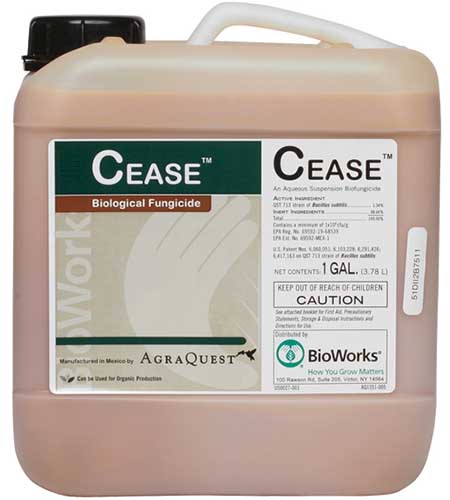


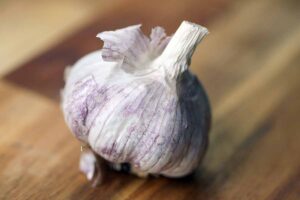
Excellent article!!
Extensive and very well documented.
Thank you
Really enjoyed reading this article, thank you for writing and posting it!
Living in zone 6a ( hot and humid) near St Louis , my coriander plants seed in 10 days. The Mint Marigold my son bought at Lowes is a substitute and so delicious ! Plus , I only had to buy one plant that became huge and healthy instead of multiple struggling coriander plants.
Excellent suggestion to use mint marigold instead of coriander in hot, humid areas. Thanks for sharing!